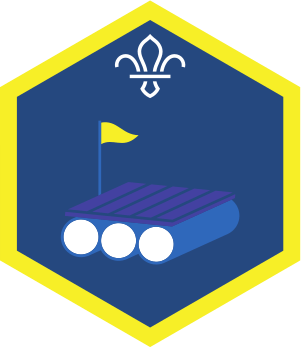
Learn about the water cycle
You’ll need
- Buckets
- Sponges
- Water bottles
- Paper cups
Before you begin
- Use the safety checklist to help you plan and risk assess your activity. There's also more guidance to help you carry out your risk assessment, including examples. Don’t forget to make sure all young people and adults involved in the activity know how to take part safely.
Planning this activity
- It’s a good idea to tell people about this game in advance, so they can come wearing clothes and suitable shoes they’re happy to get wet in.
- Ask everyone to bring a towel.
- Each stage of the game represents a stage of the water cycle.The four stages should be played one after the other to complete the water cycle relay activity.
The water cycle
Water on Earth is constantly moving. It is recycled over and over again. This recycling process is called the water cycle.
1. Water evaporates into the air
The sun heats up water on land, in rivers, lakes and seas and turns it into water vapour. The water vapour rises into the air.
2. Water vapour condenses into clouds
Water vapour in the air cools down and changes back into tiny drops of liquid water, forming clouds.
3. Water falls as precipitation
The clouds get heavy and water falls back to the ground in the form of rain or snow.
4. Water returns to the sea
Rain water runs over the land and collects in lakes or rivers, which take it back to the sea. The cycle starts all over again.
Running this activity
- Gather everyone in a circle.
- Ask if anyone knows what the water cycle is. Explain that the water cycle is the journey water takes as it moves from the land to the sky and back again. It follows a cycle of evaporation, condensation, precipitation and collection.
- Tell everyone that you’ll be playing four games to learn all about the water cycle. They might get very wet!
- Ask everyone to get into two teams, with the same number of players in each. If you’ve got a bigger group, you could play in more teams.
Evaporation moves water from where it’s collected on land to the sky. In this game, your team must be the fastest to move water from one bucket to another with a sponge.
- Fill two buckets with water, and give one to each team. These are the land.
- Each team should stand behind their land bucket, in a line.
- The other two buckets are the sky. Place one sky bucket in line with each team, a short distance away.
- Give each team a sponge.
- When the game begins, the first player in each team should put the sponge into the land bucket, and fill it with as much water as they can.
- They should run to their team’s sky bucket with their full sponge, and squeeze as much water as they can into the sky bucket.
- Once the sponge is empty, the first player should run back to their team, and pass the sponge to the next player.
- Teams continue to soak and squeeze their sponges until time runs out. The team with the most water in their sky bucket is the winner.
Condensation is the opposite of evaporation. It’s when vapour in the air turns back into a liquid and gathers in clouds. Each team must move water along the cycle into the clouds.
- Pour all of the water back into one bucket – this is the vapour bucket.
- The other two buckets are the cloud buckets. Place one cloud bucket in line with each vapour bucket.
- Teams should form a line between the vapour and sky buckets. You may need to change the distance between the buckets, so everyone can fit.
- When the game begins, the person closest to the vapour bucket should put their team’s sponge in the bucket, and soak up as much water as possible. They should use their hands to put the sponge between their chin and their chest, then put their hands behind their backs.
- The team should pass the sponge down the line, without using their hands – everyone should keep their hands behind their back.
- The last person in the line can use their hands to take the sponge from under their chin, and squeeze it into the cloud bucket. They should run to the vapour bucket (taking the sponge with them), and everyone should shuffle up a space in the line.
- Teams should continue to pass their sponge until time runs out. The team with the most water in their cloud bucket is the winner.
Precipitation is when water rains down to earth from the clouds. Your team must pass water backwards from the cloud bucket to the land.
- Pour all of the water back into one bucket – this is the cloud bucket.
- The other two buckets are the land buckets. Place one land bucket in line with each cloud bucket.
- Teams should form a line between the cloud and land buckets, facing the cloud bucket. You may need to change the distance between the buckets, so everyone can fit.
- Give everyone a cup.
- When the game begins, the person closest to the cloud bucket should fill their cup with water, and hold it on top of their head.
- Without turning around, they should bend backwards to pour the water from the cup on top of their head into the person behind them’s cup. The person behind them might need to bend down, so their cup is low, and move to ‘catch’ the water.
- Each person in the line should repeat this action.
- When the water reaches the final person in the line, they should pour it from their cup into the land bucket, without turning around.
- The last player should then run to the cloud bucket at the front of the line, and everyone should shuffle backwards one space.
- Teams should continue to pour water backwards until time runs out. The team with the most water in their land bucket is the winner.
Just like fallen water collects in oceans, rivers, and lakes, your team must be the first to collect enough water in a bottle.
- Two people from each team should sit back to back on the floor. They should each hold a plastic bottle on their head.
- The other members of their team should stand in a circle around them.
- The person leading the game should put buckets filled with water a short distance away from the teams – they should be the same distance away from each team.
- Give a cup to one person in each circle.
- When the game begins, they should run to a bucket, fill their cup with water, and run back to the circle.
- They should pour the water from the cup into one of the water bottles on their team member’s head.
- The player with the cup should return to their space in the circle, and pass the cup to the player next to them.
- Players should take it in turns to fill the cup and pour it into the bottles until time runs out, or until a team’s bottles are full. The team with the most water in their bottles is the winner.
Use spare water wisely
- Don’t waste any water you have left by pouring it down the drain — you could use it to water plants, clean, or fill a campfire water bucket.
Reflection
These games needed you to be a team player. Did you work well with your team? Were you patient with others, even when they spilled water or you got wet? How did you talk to others in your team? How did you all work towards the same goals? Did you have to put the team before yourself, for example by getting wet to catch some water your team needed? Was anyone really encouraging?
These games also needed you to problem-solve. Did you use different techniques and strategies for each game? Was being fast the only important thing – or did you need to be careful, or make a plan too? Did these games make it easier to understand the water cycle? Does acting things out help you to learn?
Safety
All activities must be safely managed. You must complete a thorough risk assessment and take appropriate steps to reduce risk. Use the safety checklist to help you plan and risk assess your activity. Always get approval for the activity, and have suitable supervision and an InTouch process.
- Active games
The game area should be free of hazards. Explain the rules of the game clearly and have a clear way to communicate that the game must stop when needed. Take a look at our guidance on running active games safely.
- Near water
Manage groups carefully when near water. The guidance on activities near water will help you to keep your group safe.
You can have as many teams as you like, as long as they’re all the same size, and you have enough equipment.
- Anyone who doesn't want to get wet could take on the role of referee.
- Adjust the distances in the game so that they’re accessible for everyone.
All Scout activities should be inclusive and accessible.
Young people can set up the mini-games themselves and referee their own races.

